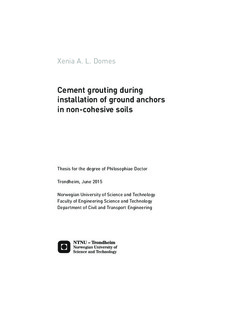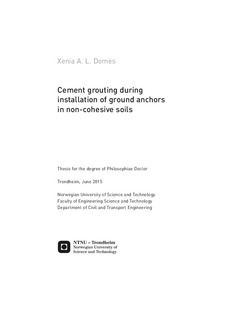| dc.description.abstract | Pressure grouting during installation of grouted ground anchors is known to increase anchor
capacity in non-cohesive soils, but little information is available on correlations between
applied grouting pressures, duration of grouting, ground conditions and increase of anchor
pull-out capacity.
The presented PhD study is concerned with processes taking place during installation
of grouted ground anchors in non-cohesive soils, where filtration of the cement grout is
assumed. It was aimed to determine the influence of pressure grouting on the stresses on the
anchor body and the properties of the adjacent soil. The knowledge of those is considered
prerequisite in order to determine the anchors pull-out capacity.
In the first part of the PhD thesis, a series of laboratory experiments is presented, which
was carried out to understand the filtration process of cement grouts and to determine the
properties of the filter cake material. Using a filtration press the rate of filter cake build-up
was investigated, taking into account the influence of grouting pressure and initial water/cement
ratio of the grout. The test results were used to evaluate different analytical approaches
to simulate the filtration process: a two-phase filtration model and classical consolidation
theory. Both models were found appropriate, and calculation parameters were determined.
In addition to the filtration tests, the mechanical properties of the fresh, uncured, filter-cake
material were investigated. Applying soil mechanical investigation methods, strength and
stiffness properties could be determined.
In the second part of the PhD thesis in-situ tests during anchor installation in sands are
presented. On three test sites the grout pressure was measured inside the borehole during
and after anchor installation. Measurements confirmed a grout filtration inside the borehole
and indicated the increase of radial stresses on the anchor body. Additional flat-dilatometer
soundings (DMT) and cone penetration tests (CPT) showed the influence of the grouting
process on the radial stresses in the adjacent soil.
In the third part of the thesis a numerical model is proposed to simulate the filtration process
of cement grout in a fully coupled flow-displacement finite element analysis. Based on
the two-phase filtration model a filter criterion was implemented, which defines the phase
change from liquid to solid grout based on the discharge of water. The phase change was
realised by changing the material properties of the grout elements. With the presented model
the grouting during anchor installation was simulated and the influence of different parameters
could be determined. The transfer of grouting pressures from the liquid grout to the soil
through seepage forces in the filtercake is simulated and the residual stresses after grouting
determined.
The findings can now be used as starting point to simulate the load transfer mechanisms
of grouted ground anchors in numerical analysis, taking into account installation effects. | nb_NO |

